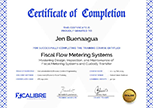| Date | Venue | Fee | |
|---|---|---|---|
| 16 Feb - 20 Feb 2026 | London - UK | $ 5,950 | Register Now |
| 16 Mar - 20 Mar 2026 | Dubai – UAE | $ 5,950 | Register Now |
| 22 Jun - 26 Jun 2026 | Dubai – UAE | $ 5,950 | Register Now |
| 14 Sep - 18 Sep 2026 | Dubai – UAE | $ 5,950 | Register Now |
| 23 Nov - 27 Nov 2026 | Istanbul - Turkey | $ 5,950 | Register Now |
About the Course
The Risk Management Process in Construction Projects training course discusses a well-defined module for risk management process (RMP) in construction projects. And to show how to measure cost and time contingency to resolve the effect of risk factors arising for different mega construction projects, as risk identified and its influence depend on projects circumstances, features and Enterprise Environmental Factors (EEF).
Managing risk is an integral framework and vital tool to achieve the main deliverables of the management system for a construction project. Although the RMP is standardised to a great extent around the world and in all projects, risk factors and risk control strategies depend on project circumstances needed to be identified and assigned for specific projects. RMP is a process to conduct these steps: Plan risk management process, identify risk categories and risk factors, conduct a qualitative and quantitative risk analysis, deliver a response plan & implementation and monitor responses for risk factors.
A project is a temporary endeavour with a specific, limited task, defined duration, and required quality (PMBOK, 2017). According to EEF, Mega construction projects are essential and have interrelated activities and specific risk factors. As these risk factors primarily affect cost and time targets, thus is an obligation to identify these risk factors and show their influence on the estimated budget and duration to achieve project deliverables.
Core Objectives
The delegates will achieve the following objectives:
- Understand the definitions of risk and description of risk management, knowing its principles and advantages
- Know mega construction project's life cycle and projects constraint cost and time and quality and its features
- Comprehend how to identify risk factors that arise for a certain construction project
- Understand how to perform a qualitative risk assessment and how to use graphical representation in decision making
- Understand how to perform a quantitative risk assessment and how to measure reserve cost and time contingency
Training Approach
The training course will depend on using a PowerPoint presentation to define risk and describe the risk management process leading all its facets. Moreover, it shows some previous studies for risk management in construction projects worldwide over the last decade. The phases of RMP and the life cycle of construction projects give various details about the scope of work (SOW) for project planning engineers in RMP and project managers through the project life cycle and how to use RMP in the project lifetime as a tool for project planning and it must be a part of decision making inside the project.
The Attendees
This training course will be valuable to professionals, including (but not limited to) the following:
- Project Managers
- Civil Work Site Engineers
- Mechanical Construction Engineers
- Infrastructure Construction Engineers
- Planning Engineers
- Procurement Engineers
- Assistant Construction Project Managers
Daily Discussion
DAY ONE: OVERVIEW
- Risk Definition
- Description of Risk Management
- Definition of Project & Construction Project Life Cycle
- Related risk factors to the construction phases
- Main deliverables and objectives of construction project management
- Risk Management Advantages: Principles & Facets
- Problem statement of construction project resolved by risk management
DAY TWO: RISK MANAGEMENT PHASES
- The chart in PMBOK concerning Risk Management Phases
- Risk Management Planning: Inputs, Outputs and Tools & Techniques
- Risk Identification: Inputs, Outputs and Tools & Techniques
- Qualitative and Quantitative Risk Analysis: Inputs, Outputs and Tools & Techniques
- Planning Risk Responses
- Implement Risk Responses
- Monitor Risk Responses
DAY THREE: RISK CATEGORIES AND RISK FACTORS - ADOPTED IN MEGA CONSTRUCTION PROJECTS
- Flow Chart Methodology of Risk Management Framework
- Risk categories and description of each risk category
- Risk Factors (RF) defined and subsidiary form each risk category
- Questionnaire survey to identify and analyse risk factors
- The intensity of each RF showing mean value and the standard deviation of these risk factors
- Correlation Method from Quantitative Analysis
- Point of view of Risk Factors:
- The intensity of each RF and the category of these risk factors
- At which phase these (RF) occur
- The cause of variation from standard deviation and correlation with other (RF)
- How to control this risk factor?
- Graphical Representation of Risk Management Process
DAY FOUR: APPLICATION OF RISK MANAGEMENT PROCESS
- Methods of both Qualitative and Quantitative Analysis
- Qualitative Analysis of Severity and Probability (S/P) Matrix
- Quantitative Analysis of Analytical Hierarchy Process (AHP)
- Integration between qualitative and quantitative for measuring Cost and Time Contingency
- Hazard Risk Identification and Risk Assessment
- Sustainable Development Goals (SDG) and their relation to the Risk Management Process
- Energy and Material Consumption: The main deliverables of a successful risk management process
DAY FIVE: RISK MANAGEMENT PROCESS IN DIFFERENT PROJECTS
- Natural Gas Pipeline
- Natural Gas Plant Process
- Construction of Residential Buildings
- Construction of Water Control Structures
Certificate Awarded
Upon successful completion of this training course, participants will be awarded a Certificate of Completion from XCalibre Training Centre, acknowledging their accomplishment. This certificate serves as a testament to their dedication to developing their skills and advancing their expertise in their respective fields.


